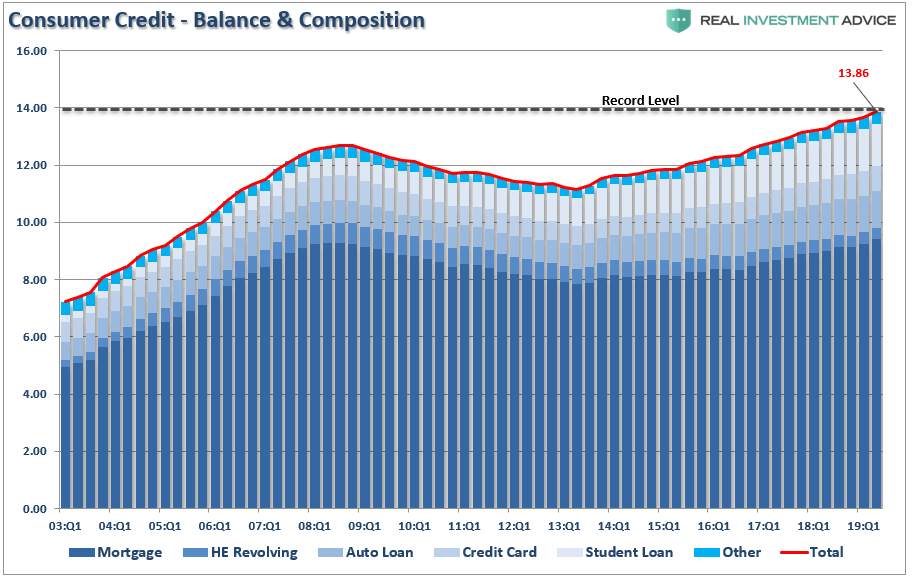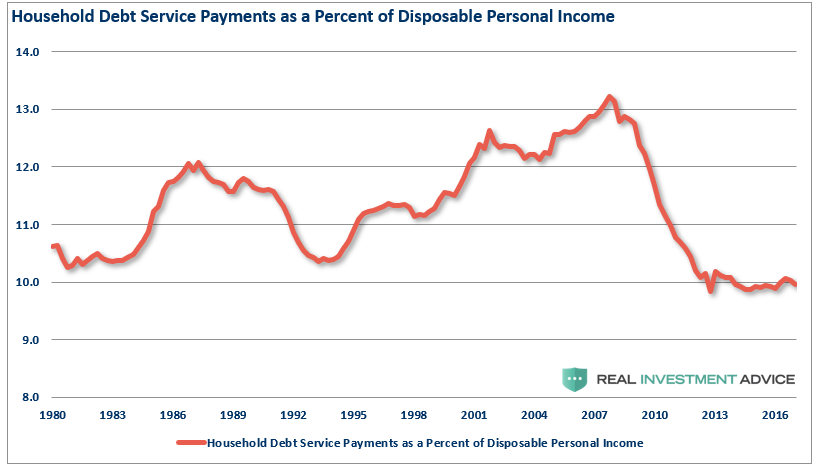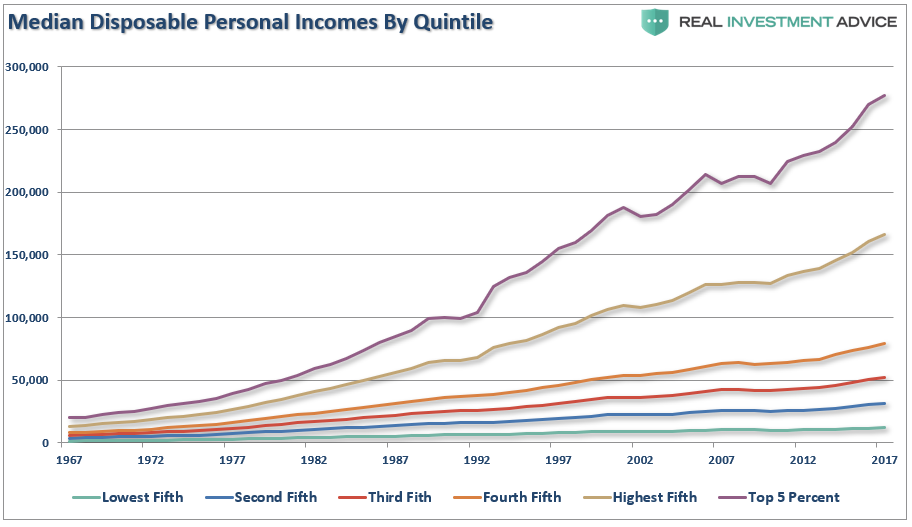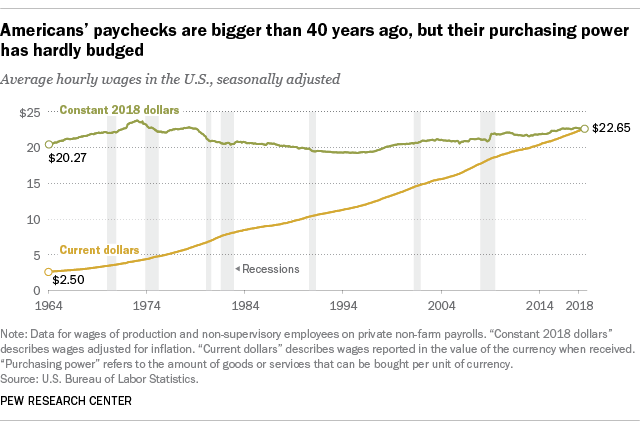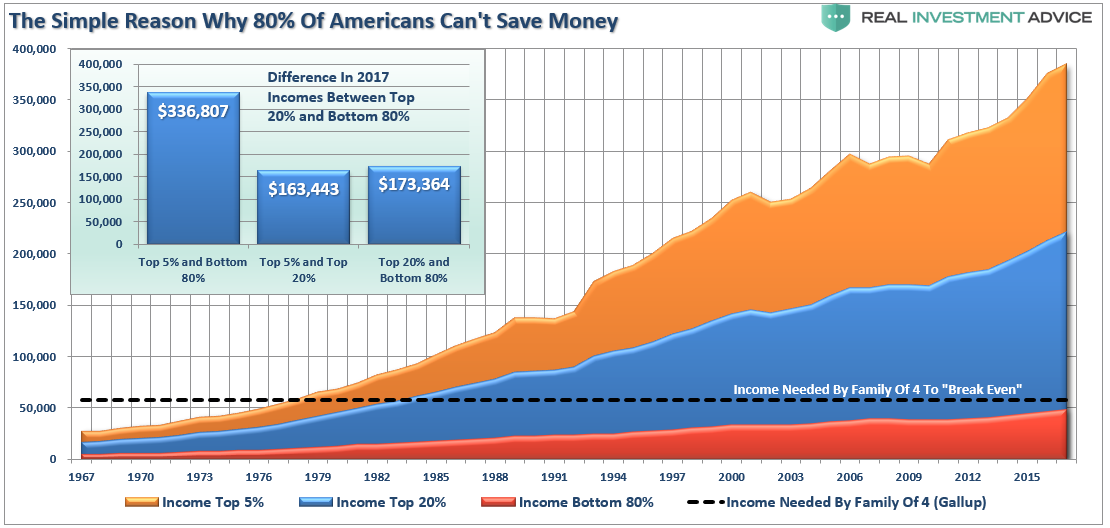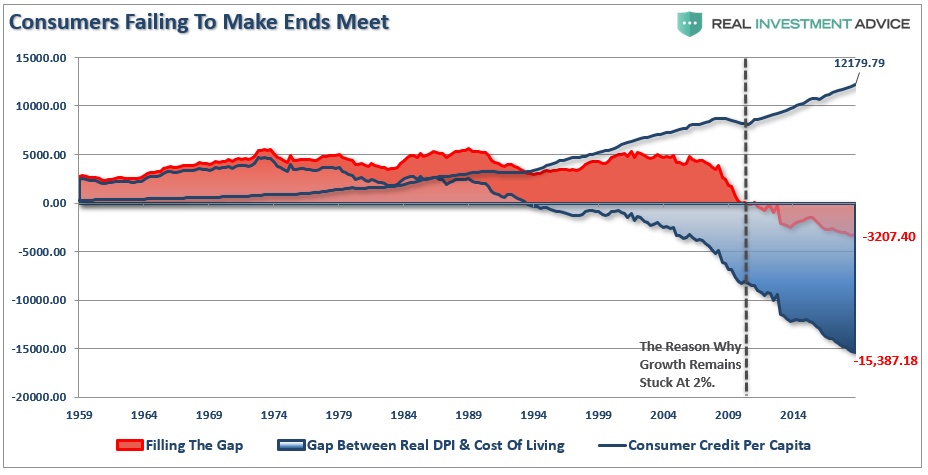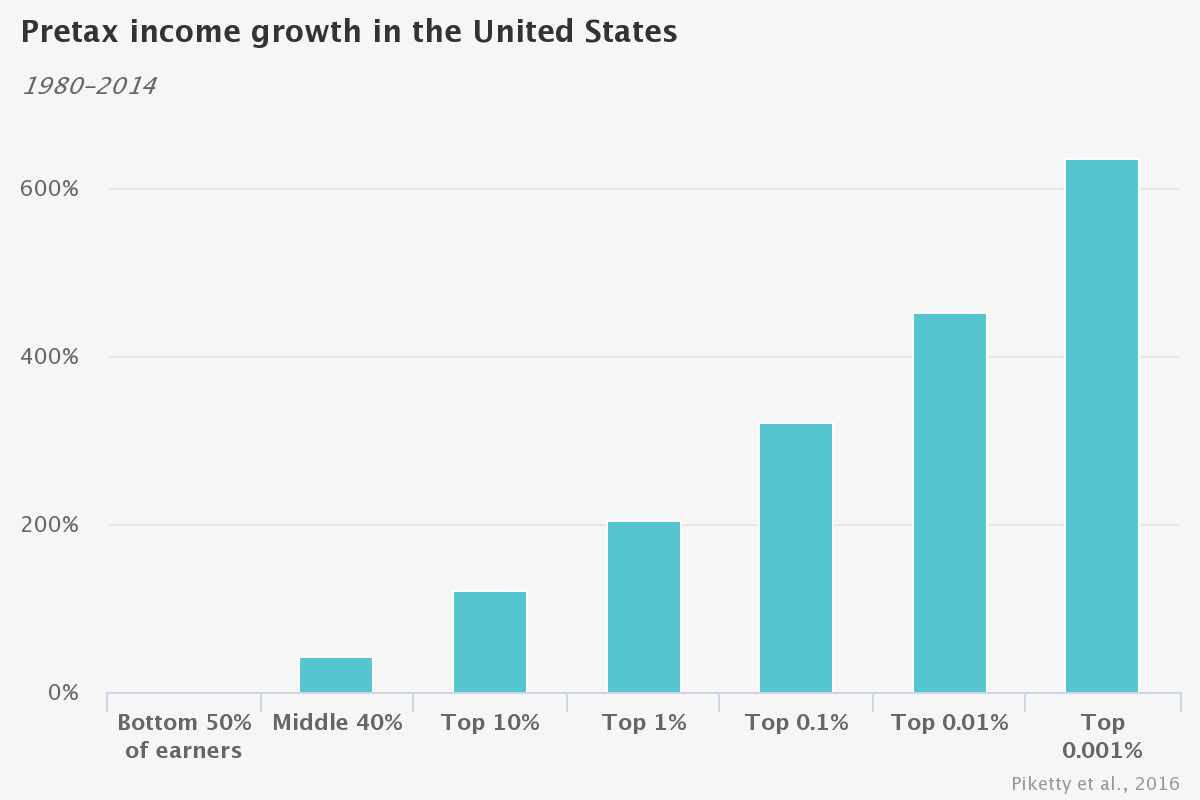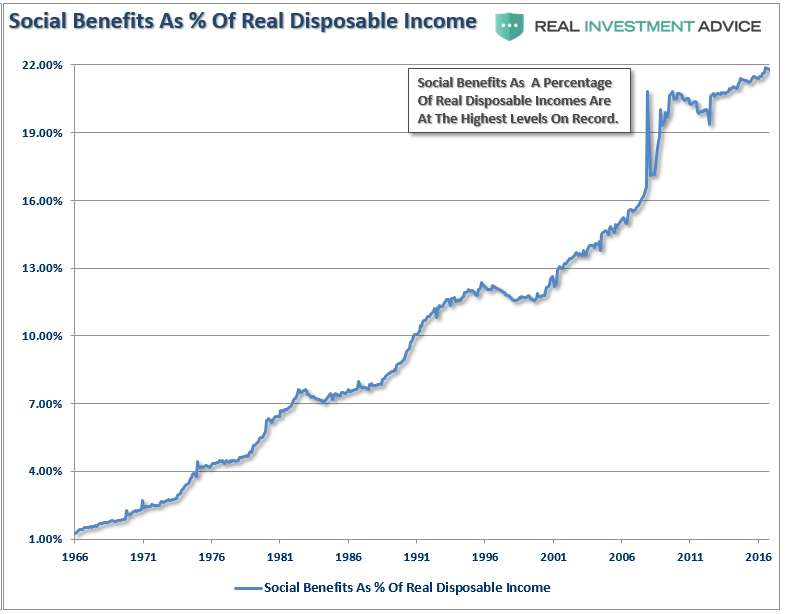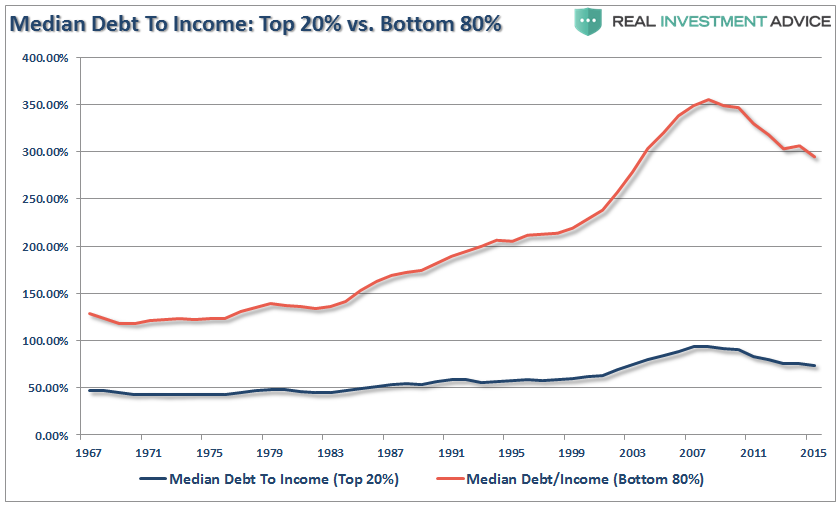Authored by Lance Roberts via RealInvestmentAdvice.com,
Just recently, Rex Nutting penned an opinion piece for MarketWatch entitled “Consumer Debt Is Not A Ticking Time Bomb.” His primary point is that low per-capita debt ratios and debt-to-dpi ratios show the consumer is quite healthy and won’t be the primary subject of the next crisis. To wit:
“However, most Americans are better off now than they were 10-years ago, or even a few years ago. The finances of American households are strong.
But, that’s not what a lot of people think. More than a decade after a massive credit orgy by households brought down the U.S. and global economies, lots of people are convinced that households are still borrowing so much money that it will inevitably crash the economy.
Those critics see a consumer debt bomb growing again. But they are wrong.”
I do agree with Rex on his point that the U.S. consumer won’t be the sole cause of the next crisis. It will be a combination of household and corporate debt combined with underfunded pensions, which will collide in the next crisis.
However, there is a household debt problem which is hidden by the way governmental statistics are calculated.
Indebted To The American Dream
The idea of “maintaining a certain standard of living” has become a foundation in our society today.Americans, in general, have come to believe they are “entitled” to a certain type of house, car, and general lifestyle which includes NOT just the basic necessities of living such as food, running water, and electricity, but also the latest mobile phone, computer, and high-speed internet connection. (Really, what would be the point of living if you didn’t have access to Facebook every two minutes?)
But, like most economic data, you have to dig behind the numbers to reveal the true story.
So let’s do that, shall we?
Every quarter the Federal Reserve Bank of New York releases its quarterly survey of the composition and balances of consumer debt. (Note that consumers are at record debt levels and roughly $1 Trillion more than in 2008.)
One of the more interesting points made to support the bullish narrative was that record levels of debt is irrelevant because of the rise in disposable personal incomes. The following chart was given as evidence to support that claim.
Looks pretty good, as long as you don’t scratch too deeply.
To begin with, the calculation of disposable personal income (which is income less taxes) is largely a guess, and very inaccurate, due to the variability of income taxes paid by households.
More importantly, the measure is heavily skewed by the top 20% of income earners, needless to say, the top 5%. As shown in the chart below, those in the top 20% have seen substantially larger median wage growth versus the bottom 80%.
(Note: all data used below is from the Census Bureau and the IRS.)
Furthermore, disposable and discretionary incomes are two very different animals.
Discretionary income is what is left of disposable incomes after you pay for all of the mandatory spending like rent, food, utilities, health care premiums, insurance, etc.
From this view, the “cost of living” has risen much more dramatically than incomes. According to Pew Research:
“In fact, despite some ups and downs over the past several decades, today’s real average wage (that is, the wage after accounting for inflation) has about the same purchasing power it did 40 years ago. And what wage gains there have been have mostly flowed to the highest-paid tier of workers.”
But the problem isn’t just the cost of living due to inflation, but the “real” cost of raising a family in the U.S. has grown incredibly more expensive with surging food, energy, health, and housing costs.
-
Researchers at Purdue University recently studied data culled from across the globe and found that in the U.S., $132,000 was found to be the optimal income for “feeling” happy for raising a family of four.
-
Gallup also surveyed to find out what the “average” family required to support a family of four in the U.S. (Forget about being happy, we are talking about “just getting by.”) That number turned out to be $58.000.
So, while the “median” income has broken out to highs, the reality for the vast majority of Americans is there has been little improvement. Here are some stats from the survey data which was NOT reported:
-
$306,139 – the difference between the annual income for the Top 5% versus the Bottom 80%.
-
$148,504 – the difference between the annual income for the Top 5% and the Top 20%.
-
$157,635 – the difference between the annual income for the Top 20% and the Bottom 80%.
If you are in the Top 20% of income earners, congratulations.
If not, it is a bit of a different story.
Assuming a “family of four” needs an income of $58,000 a year to just “make it,” such becomes problematic for the bottom 80% of the population whose wage growth falls far short of what is required to support the standard of living, much less to obtain “happiness.”
This is why the “gap” between the “standard of living” and real disposable incomes is more clearly shown below. Beginning in 1990, incomes alone were no longer able to meet the standard of living so consumers turned to debt to fill the “gap.” However, following the “financial crisis,” even the combined levels of income and debt no longer fill the gap. Currently, there is almost a $3200 annual deficit that cannot be filled.
Record levels of consumer debt is a problem. There is simply a limit to how much “debt” each household can carry even at historically low interest rates.
Data Skew
While Rex’s analysis is not incorrect, the data he is using in his assumptions is being skewed by the “wealth and income” gap in the top 20% of the population. This was a point put forth in a study from Chicago Booth Review:
“The data set reveals since 1980 a ‘sharp divergence in the growth experienced by the bottom 50 percent versus the rest of the economy,’ the researchers write. The average pretax income of the bottom 50 percent of US adults has stagnated since 1980, while the share of income of US adults in the bottom half of the distribution collapsed from 20 percent in 1980 to 12 percent in 2014. In a mirror-image move, the top 1 percent commanded 12 percent of income in 1980 but 20 percent in 2014. The top 1 percent of US adults now earns on average 81 times more than the bottom 50 percent of adults; in 1981, they earned 27 times what the lower half earned.“
Given this information, it should not be surprising that personal consumption expenditures, which make up roughly 70% of the economic equation, have had to be supported by surging debt levels to offset the lack wage growth in the bottom 80% of the economy.
More importantly, despite economic reports of rising employment, low jobless claims, surging corporate profitability and continuing economic expansion, the percentage of government transfer payments (social benefits) as compared to disposable incomes have surged to the highest level on record.
This anomaly was also noted in the study:
“Government transfer payments have ‘offset only a small fraction of the increase in pre-tax inequality,’ Piketty, Saez, and Zucman conclude—and those payments fail to bridge the gap for the bottom 50 percent because they go mostly to the middle class and the elderly. Pretax income of the middle class (adults between the median and the 90th percentile) has grown 40 percent since 1980, ‘faster than what tax and survey data suggest, due in particular to the rise of tax-exempt fringe benefits,’ the researchers write. ‘For the working-age population, post-tax bottom 50 percent income has hardly increased at all since 1980.’”
Here is the point that Rex missed. There is a vast difference between the level of indebtedness (per household) for those in the bottom 80%, versus those in the top 20%.
Of course, the only saving grace for many American households is that artificially low interest rates have reduced the average debt service levels. Unfortunately, those in the bottom 80% are still having a large chunk of their median disposable income eaten up by debt payments. This reduces discretionary spending capacity even further.
The problem is quite clear. With interest rates already at historic lows, the consumer already heavily leveraged, and wage growth stagnant, the capability to increase consumption to foster higher rates of economic growth is limited.
With respect to those who say “the debt doesn’t matter,” I respectfully argue that you looking at a very skewed view of the world driven by those at the top.
The Next Crisis Will Be The Last
For the Federal Reserve, the next “financial crisis” is already in the works. All it takes now is a significant decline in asset prices to spark a cascade of events that even monetary interventions may be unable to stem.
However, to Rex’s credit, households WILL NOT be the sole catalyst of the next crisis.
The real crisis comes when there is a “run on pensions.” With a large number of pensioners already eligible for their pension, the next decline in the markets will likely spur the “fear” that benefits will be lost entirely. The combined run on the system, which is grossly underfunded, at a time when asset prices are dropping will cause a debacle of mass proportions. As noted above, it is going to require a massive government bailout to resolve it.
But, consumers will “contribute their fair share.” Consumers are once again heavily leveraged with sub-prime auto loans, mortgages, and student debt. When the recession hits, the reduction in employment will further damage what remains of personal savings and consumption ability. The downturn will increase the strain on an already burdened government welfare system as an insufficient number of individuals paying into the scheme is being absorbed by a swelling pool of aging baby-boomers now forced to draw on it. Yes, more Government funding will be required to solve that problem as well.
As debts and deficits swell in coming years, the negative impact to economic growth will continue. At some point, there will be a realization of the real crisis. It isn’t a crash in the financial markets that is the real problem, but the ongoing structural shift in the economy that is depressing the living standards of the average American family. There has indeed been a redistribution of wealth in America since the turn of the century. Unfortunately, it has been in the wrong direction as the U.S. has created its own class of royalty and serfdom.
The good news is that it can all be solved by the issuance of more debt.
The bad news comes when there are no buyers willing to continue to fund fiscal irresponsibility.
The next “crisis,” will be the “great reset” which will also make it the “last crisis.”
via ZeroHedge News https://ift.tt/329ojQF Tyler Durden
